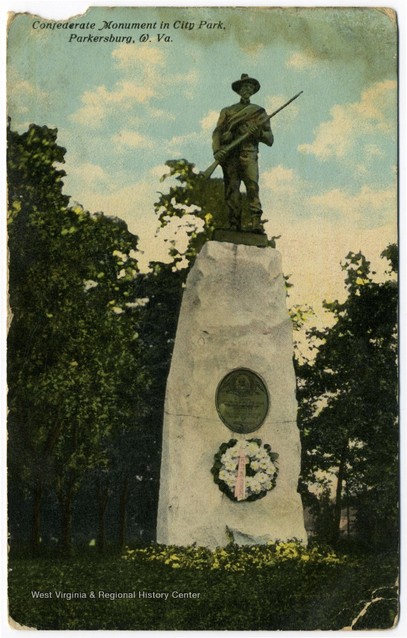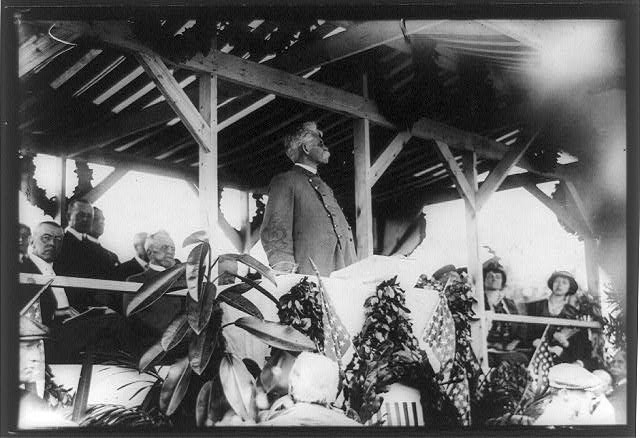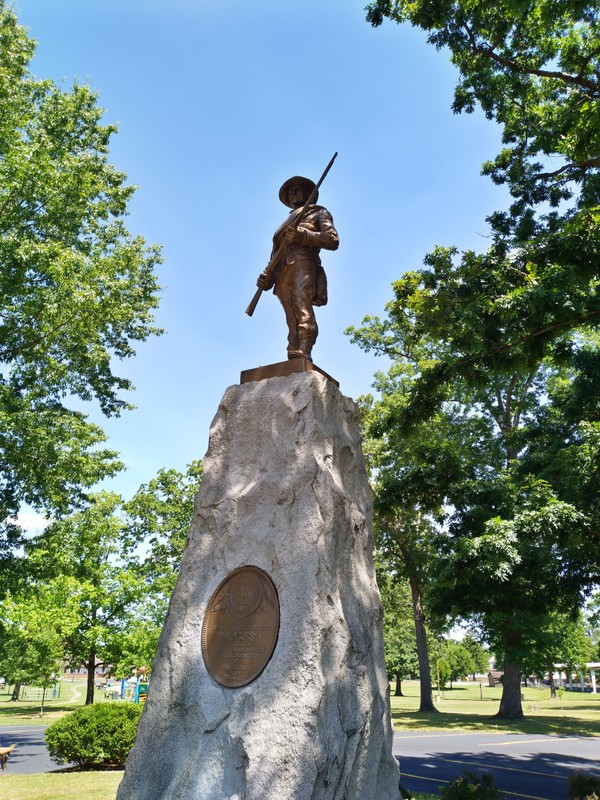Parkersburg Confederate Monument
Introduction
Text-to-speech Audio
Images
Historic postcard of the Parkersburg Confederate Monument.

Bennett H. Young, dedicating a Confederate monument in Arlington, Virginia, 1914.

Parkersburg Confederate Monument.

Parkersburg Confederate Monument plaque.

Backstory and Context
Text-to-speech Audio
During the Civil War, Parkersburg proved itself a firm Union town. Approximately 3,000 soldiers from Wood County enlisted in the United States army, while some 500 local citizens enlisted in Confederate service. The town also possessed a degree of strategic importance, as it set along the vital east-west Baltimore & Ohio Railroad. Fort Boreman was built overlooking Parkersburg to protect the town and rail line.
Despite its relatively minimal Confederate legacy, the Parkersburg Chapter of the United Daughters of the Confederacy (UDC) determined to erect a monument to local Confederate dead. Wanting to honor Confederate veterans and also promoting "Lost Cause" ideology that minimized the role of slavery and Confederate defeat, the UDC supported the construction of many such monuments across the South. It took seven years for the local UDC chapter to raise the requisite $2,600 necessary for the statue's construction, and the City of Parkersburg donated a small plot of land for its use. The monument consists of a 12-foot pedestal of Vermont granite, in which is set a bronze plaque reading, "In Memory of Our Confederate Dead: Erected by the Parkersburg Chapter United Daughters Confederacy 1908" and is likewise inscribed with the Confederate seal. The granite pedestal is topped by a seven-foot bronze Confederate soldier, which was sculpted by French-American artist Leon Hermant.
The monument was dedicated on July 21, 1908. The key speaker was Bennett H. Young. A former Confederate colonel (who notably led a Rebel raid on St. Albans, Vermont from Canada), Young rose to prominence within the United Confederate Veterans, ultimately serving two terms as its Commander-in-Chief. A noted orator, Young routinely spoke at Confederate monument dedications. Speaking in Parkersburg, Young proudly proclaimed that the Confederate army "constituted the most homogeneous organization that every bore the Anglo-Saxon name."[1]
Following the dedication, the UDC held annual Memorial Day ceremonies at the monument for a number of years. According to local West Virginia historian Bob Arrington, complete accounts of Wood County's soldiers have not been compiled. Some estimates place the number of Union soldiers at 3,000 and Confederate at 500, but the 1860 census shows only 2,114 men between the ages of 15-40 in Wood County. Further complicating an accurate account is the number of Ohioans who crossed from Marietta and Washington County to join western Virginia regiments when Ohio's Federal quota had been filled. The adjutant general's report of 1865 credits Wood County with 2,180 men, but this would include the Ohioans as well. Ohio contributed nearly five regiments of volunteers credited to West Virginia. De Beck's Battery of the Ohio Light Artillery is often credited to Wood County, but recruitment was slow in Wood County and it was moved back to Ohio.
An incomplete database of Virginia's War Dead assigns twelve Confederate and three Union casualties to Wood County. The Union dead were from the 6th & 11th West Virginia Infantry and the other was from the 28th U.S. Colored Infantry. The Confederate dead were from the 5th, 31st and 36th Virginia Infantry, and the 17th and 19th Virginia Cavalry. Wood County Confederates were also enlisted in 14th and 20th Cavalry regiments, as well as the 26th Cavalry, which was recruited by Wood County's Brig. Gen. William L. Jackson, primarily in West Virginia.
Capt. Paul Neal, born in 1832 in Parkersburg, operated the Confederate recruiting station on Market St., where he formed the Wood County Grays, which became Co. G of the 20th Virginia Cavalry, and the Night Hawk Rangers, which became Co. F of the 17th Virginia Cavalry. The 20th Cavalry regiment was composed of West Virginians, except for two companies from Rockbridge County. The 17th Cavalry was also mostly from West Virginia except for some recruits from Giles County, Virginia.
Cite This Entry
Cowsert, Zachery et. al. "Parkersburg Confederate Monument." Clio: Your Guide to History. April 13, 2021. Accessed April 6, 2025. https://theclio.com/tour/1473/1
Sources
Andrews, Martin R.. History of Marietta and Washington County, Ohio, and representative citizens, Accessed January 25th 2021. https://archive.org/details/historyofmariett01andr/page/630/mode/2up?q=de+beck.
Annual report of the Adjutant General of the State of West Virginia for the year ending December 31, 1864, Accessed January 25th 2021. https://archive.org/details/annualreportofad1864west/page/736/mode/2up.
1. Brown, Thomas J. Civil War Monuments and the Militarization of America. Chapel Hill: University of North Carolina Press, 2019. https://uncpress.org/book/9781469653747/civil-war-monuments-and-the-militarization-of-america/
Crooks, M.D., Robert D. "The Civil War in Greater Parkersburg." Visit Greater Parkersburg. Web. Accessed July 8, 2020. https://www.greaterparkersburg.com/things-to-do/history-heritage/civil-war/
Database of Virginia Military Dead, Accessed January 25th 2021. https://www.lva.virginia.gov/public/guides/vmd/vmd_Search.asp.
Emerson, B.A.C. Historic Southern Monuments: Representative Memorials of the Heroic Dead of the Southern Confederacy. New York: Neale Publishing Company, 1911. Accessed via Google Books: https://play.google.com/store/books/details?id=Qhx3AAAAMAAJ&rdid=book-Qhx3AAAAMAAJ&rdot=1
Giguere, Joy M. "Bennett H. Young and the Rhetoric of Reconciliation." Veterans in Society Conference, Virginia Tech. 2015. Web. Accessed July 9, 2020. https://vtechworks.lib.vt.edu/handle/10919/72927
Interview: Mark Snell, “West Virginia and the Civil War”, Accessed January 25th 2021. https://bullrunnings.wordpress.com/2011/11/17/interview-mark-snell-west-virginia-and-the-civil-war/.
Matheny, H. E.. Wood County, West Virginia, In Civil War Times, Accessed January 25th 2021. https://www.worldcat.org/title/wood-county-west-virginia-in-civil-war-times-with-an-account-of-the-guerrilla-warfare-in-the-little-kanawha-valley/oclc/17805775.
Mountaineers of the Blue and Gray, The Civil War and West Virginia, George Tyler Moore Center for the Study of the Civil War, Shepherd Univ., 2008, CD-Rom, Accessed January 25th 2021.
Population of the United States in 1860; compiled from the original returns of the eighth census under the direction of the Secretary of the Interior by Joseph C.G. Kennedy, Accessed January 25th 2021. https://archive.org/details/populationofusin00kennrich/page/500/mode/2up.
Reid, Whitelaw. Ohio in the War; Her statesmen, Her generals, and Soldiers, Vol. II, Accessed January 25th 2021. https://archive.org/details/ohioinwarherstat00reid/page/n11/mode/2up.
Volunteers of Washington County, Ohio: War of the Rebellion 1861-1865, Accessed January 25th 2021. https://archive.org/stream/volunteersofwash00newt.

